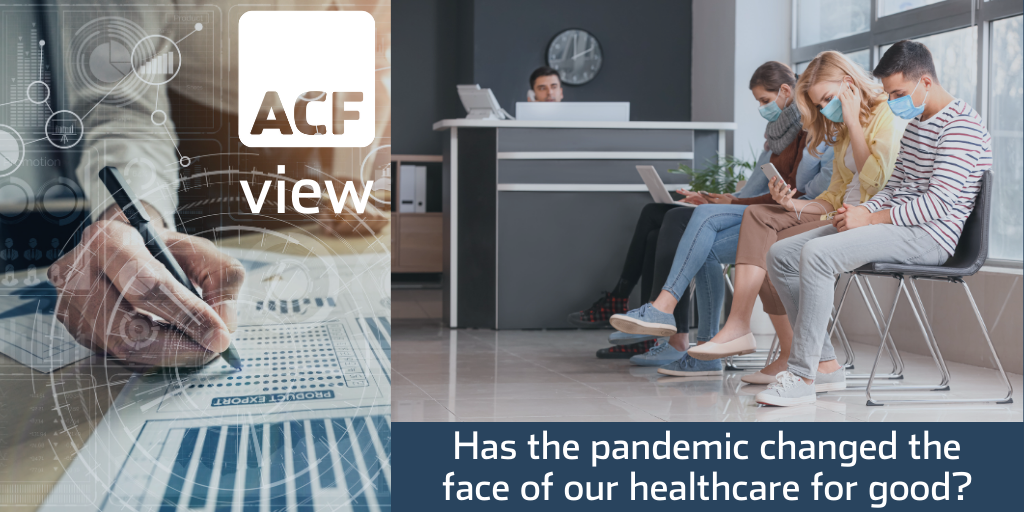Will an innovative healthcare IT system change healthcare as we know it during Covid-19?
West Kent Health, a GP lead Federation comprised of 55 practices, was featured in Healthcare Newsdesk on 16 August 2020 thanks to its Vision Shared Care Solutions – intelligent healthcare software that facilitates the appointment process and provides easier access to patient records.
Vision Health’s view came about as a result of the many reasons why the current NHS system needs innovation, as shown in Exhibit 1 below.
Exhibit 1 – NHS pressures/challenges on primary care, 2020

Sources: ACF Equity Research; Vision Health
As a result of Covid, many healthcare facilities have had to combine resources and work together in order to care for patients that were not affected by the virus and as a result may have been unable to access hospital facilities or clinics for routine treatment.
These ‘shared care’ services were necessary during Covid I, and may very well continue as we go into Covid II and then into the new normal post-covid – it has become an essential primary care goal to ameliorate patient access to primary care and provide rapid access to patient information across multi-specialised teams.
The overall goal is to improve access to certain shared services from diabetes clinics to out-of-hours appointments using better healthcare IT systems.
West Kent Health’s ‘Vision Anywhere’ allows for easier access to patient records in order to facilitate patient treatment via shared care services. Specialists and physicians can cater to patient needs a lot faster, according to West Kent Health.
Vision Shared Appointments provides a centralised appointment system that both patients and healthcare providers can access in real time, the GP Federation claims.
The GP Federation says the platforms are simple to use for all parties and nurses are able to add notes to patient’s boxes (i.e. files) in order to request prescriptions or highlight points about the patient’s needs.
Notes from referrals are also added to the patient box, apparently quicker, and in turn the improved outcome according to the Federation is that patients can be seen by the correct providers, faster.
Appointment waiting times are reduced significantly according to the Federation, which also suggests a better allocation of resources that may well lead to shorter travel distances for patients and practioners.
An example of where this IT system could easily make a significant different is for diabetes patients who in the past may have had to travel to diabetes specialised hospitals. With the new proposed IT system these patients are expected to be are able to gain access to local clinics.
The Federation also points out that the system should allow medical receptionists to book out-of-hours appointments in nearby practices in order to reduce waiting times at hospitals. Patients have apparently indicated that they are willing to travel to a different practice as long as they can see a GP more quickly, which seems rational.
Haydyn Williams, Senior Administrator at West Kent Health, has observed that “Waiting times at hospital have also dropped. Patients are seen more quickly, they have more one to one time and are being discharged quicker.”
This is an example where simple collaboration supported by a new model and added to the will to improve care services, appears to have made a significant difference (we have not verified the actual stats). However, if the stats bare interrogation, IT systems such as Vision’s should be rolled out globally and quickly as demand increases.
The Covid-19 health crisis has opened the door to many successful and innovative healthcare models such as that introduced by West Kent Health.
As a result of Covid I, access to primary healthcare became more limited, took longer and sometimes was just not available. We expect platforms such as Vision and other clinical IT solutions along with Telemedicine to make fundamental changes to the healthcare model in terms of efficiency for patients and costs to insurers and governments.
These platforms, clinical IT solutions and telemedicine will also change the revenue or reimbursement model for hospitals, which will force hospitals to review their entire operations from infrastructure to service offering.
If it was ever in doubt over the last decade, it is now unavoidable to conclude that the healthcare industry cannot function without technology and its AI sub-sector.
This has opened up a lot of opportunities for smaller companies to enter the market. As a corollary, we have seen, and continue to expect, an upsurge in healthcare IPOs.
The funding and investor interest is there (and is essential) to support growth of these currently niche markets. At the moment, it seems the only way is up for investor returns. It is a long time since anyone has been able to say that about healthcare investing.
















